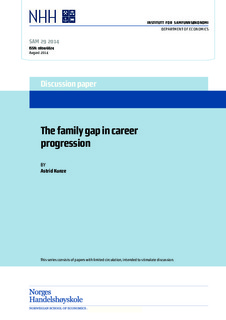The family gap in career progression
| dc.contributor.author | Kunze, Astrid | |
| dc.date.accessioned | 2014-09-22T10:05:57Z | |
| dc.date.available | 2014-09-22T10:05:57Z | |
| dc.date.issued | 2014-08 | |
| dc.identifier.issn | 0804-6824 | |
| dc.identifier.uri | http://hdl.handle.net/11250/220831 | |
| dc.description.abstract | This study investigates whether and when during the life cycle women fall behind in terms of career progression because of children. We use 1987-1997 Norwegian panel data that contain information on individuals’ position in their career hierarchy as well as a direct measure of their promotions. We measure overall promotions as increases in rank within the same establishment as well as in combination with an establishment change. Women with children are 1.6 percentage points less likely promoted than women without children; this is what we refer to as the family gap in climbing the career. We find that mothers tend to enter on lower ranks than non-mothers. 37 percent of the gap can be explained by rank fixed effects and human capital characteristics. A large part remains unexplained. Graphical analyses show that part of the difference already evolves during the early career. Part of this seems related to the relatively low starting ranks. | nb_NO |
| dc.language.iso | eng | nb_NO |
| dc.publisher | SAM | nb_NO |
| dc.relation.ispartofseries | Discussion paper;29/14 | |
| dc.subject | promotion | nb_NO |
| dc.subject | women | nb_NO |
| dc.subject | family gap | nb_NO |
| dc.subject | human capital | nb_NO |
| dc.subject | organizational hierarchy | nb_NO |
| dc.subject | decomposition | nb_NO |
| dc.title | The family gap in career progression | nb_NO |
| dc.type | Working paper | nb_NO |
Files in this item
This item appears in the following Collection(s)
-
Discussion papers (SAM) [657]
